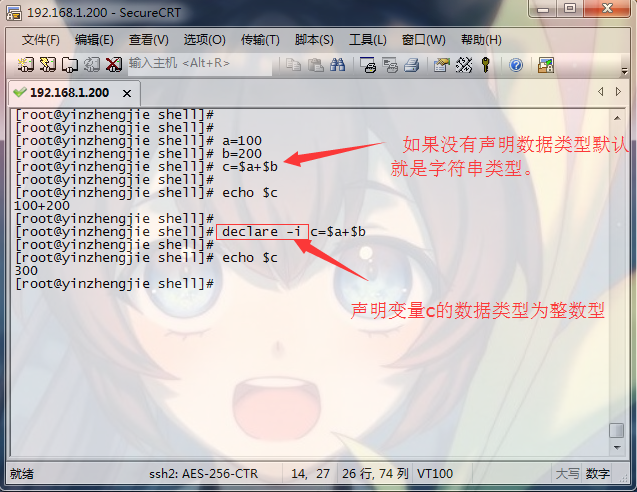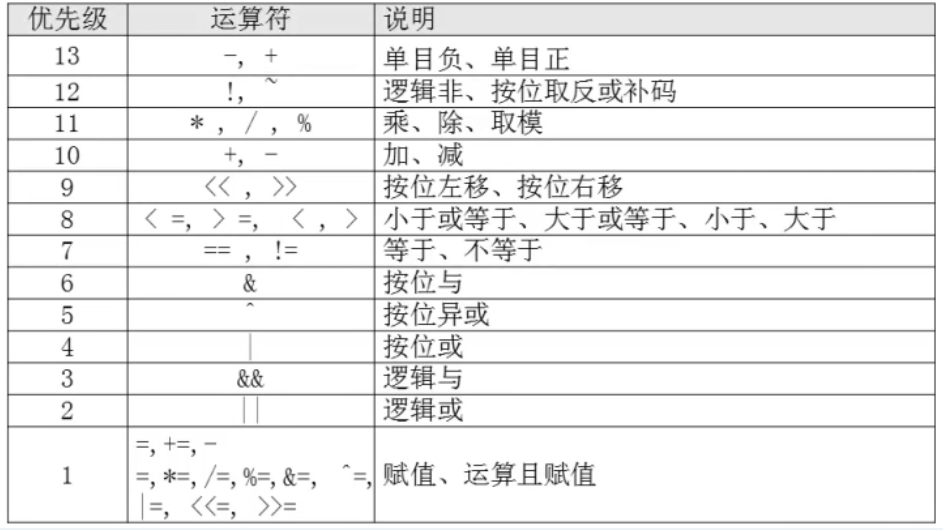SHELL脚本编程的运算符
作者:尹正杰
版权声明:原创作品,谢绝转载!否则将追究法律责任。
一.算数运算
1>.bash中的算数运算

[root@node101.yinzhengjie.org.cn ~]# help let let: let arg [arg ...] Evaluate arithmetic expressions. Evaluate each ARG as an arithmetic expression. Evaluation is done in fixed-width integers with no check for overflow, though division by 0 is trapped and flagged as an error. The following list of operators is grouped into levels of equal-precedence operators. The levels are listed in order of decreasing precedence. id++, id-- variable post-increment, post-decrement ++id, --id variable pre-increment, pre-decrement -, + unary minus, plus !, ~ logical and bitwise negation ** exponentiation *, /, % multiplication, division, remainder +, - addition, subtraction <<, >> left and right bitwise shifts <=, >=, <, > comparison ==, != equality, inequality & bitwise AND ^ bitwise XOR | bitwise OR && logical AND || logical OR expr ? expr : expr conditional operator =, *=, /=, %=, +=, -=, <<=, >>=, &=, ^=, |= assignment Shell variables are allowed as operands. The name of the variable is replaced by its value (coerced to a fixed-width integer) within an expression. The variable need not have its integer attribute turned on to be used in an expression. Operators are evaluated in order of precedence. Sub-expressions in parentheses are evaluated first and may override the precedence rules above. Exit Status: If the last ARG evaluates to 0, let returns 1; let returns 0 otherwise. [root@node101.yinzhengjie.org.cn ~]#
+, -, *, /, %取模(取余), **(乘方),乘法符号有些场景中需要转义。 实现算术运算: (1) let var=算术表达式 (2) var=$[算术表达式] (3) var=$((算术表达式)) (4) var=$(expr arg1 arg2 arg3 ...) (5) declare –i var = 数值 (6) echo ‘算术表达式’ | bc 增强型赋值: +=, -=, *=, /=, %= let varOPERvalue 例如:let count+=3 自加3后自赋值 自增,自减: let var+=1 let var++ let var-=1 let var--

[root@node101.yinzhengjie.org.cn ~]# x=3 [root@node101.yinzhengjie.org.cn ~]# y=8 [root@node101.yinzhengjie.org.cn ~]# [root@node101.yinzhengjie.org.cn ~]# let num=$x*$y [root@node101.yinzhengjie.org.cn ~]# echo $num [root@node101.yinzhengjie.org.cn ~]# [root@node101.yinzhengjie.org.cn ~]# let num=x*y [root@node101.yinzhengjie.org.cn ~]# echo $num [root@node101.yinzhengjie.org.cn ~]# [root@node101.yinzhengjie.org.cn ~]# echo $[x-y] -6 [root@node101.yinzhengjie.org.cn ~]# echo $[x**y] [root@node101.yinzhengjie.org.cn ~]# echo $[y%x] [root@node101.yinzhengjie.org.cn ~]# [root@node101.yinzhengjie.org.cn ~]# i=10 [root@node101.yinzhengjie.org.cn ~]# echo $i 10 [root@node101.yinzhengjie.org.cn ~]# ((i++)) #等价于i=i+1,表示要先使用i变量后,在对其进行加1操作。 [root@node101.yinzhengjie.org.cn ~]# [root@node101.yinzhengjie.org.cn ~]# echo $i 11 [root@node101.yinzhengjie.org.cn ~]# unset i [root@node101.yinzhengjie.org.cn ~]# [root@node101.yinzhengjie.org.cn ~]# m=10 [root@node101.yinzhengjie.org.cn ~]# let ++m #在循环中使用会需要先对m变量进行加1在使用它。 [root@node101.yinzhengjie.org.cn ~]# echo $m 11 [root@node101.yinzhengjie.org.cn ~]# [root@node101.yinzhengjie.org.cn ~]# echo $x 2 [root@node101.yinzhengjie.org.cn ~]# echo $y 8 [root@node101.yinzhengjie.org.cn ~]# [root@node101.yinzhengjie.org.cn ~]# expr $x * $y 16 [root@node101.yinzhengjie.org.cn ~]# [root@node101.yinzhengjie.org.cn ~]# declare -i m=10 [root@node101.yinzhengjie.org.cn ~]# declare -i n=20 [root@node101.yinzhengjie.org.cn ~]# declare -i num=m+n [root@node101.yinzhengjie.org.cn ~]# echo $num 30 [root@node101.yinzhengjie.org.cn ~]# [root@node101.yinzhengjie.org.cn ~]# echo "100 * 2" | bc 200 [root@node101.yinzhengjie.org.cn ~]# [root@node101.yinzhengjie.org.cn ~]# x=10 [root@node101.yinzhengjie.org.cn ~]# let x+=2 [root@node101.yinzhengjie.org.cn ~]# echo $x 12 [root@node101.yinzhengjie.org.cn ~]# let x-=4 [root@node101.yinzhengjie.org.cn ~]# echo $x 8 [root@node101.yinzhengjie.org.cn ~]# [root@node101.yinzhengjie.org.cn ~]# let x/=3 #不支持浮点数,因此除等得到的值只能取整数。 [root@node101.yinzhengjie.org.cn ~]# echo $x 2 [root@node101.yinzhengjie.org.cn ~]#
2>.bash有内建的随机生成器变量:"$RANDOM(0-32767)"
[root@node101.yinzhengjie.org.cn ~]# man bash #保存了BASH中默认存在的变量,RANDOM只是其中之一。 [root@node101.yinzhengjie.org.cn ~]# echo $RANDOM 5250 [root@node101.yinzhengjie.org.cn ~]# [root@node101.yinzhengjie.org.cn ~]# echo $RANDOM 2602 [root@node101.yinzhengjie.org.cn ~]# [root@node101.yinzhengjie.org.cn ~]# echo $RANDOM #默认生成 0 - 32767 之间随机数 29339 [root@node101.yinzhengjie.org.cn ~]# [root@node101.yinzhengjie.org.cn ~]# echo $[$RANDOM%50] #生成 0 - 49 之间随机数 47 [root@node101.yinzhengjie.org.cn ~]# [root@node101.yinzhengjie.org.cn ~]# echo $[$RANDOM%50] 36 [root@node101.yinzhengjie.org.cn ~]# [root@node101.yinzhengjie.org.cn ~]# echo $[$RANDOM%50] 32 [root@node101.yinzhengjie.org.cn ~]#
3>.declare声明变量类型

4>.数值运算

5>.expr或let数值运算工具

6>.“$((运算式))”或"$[运算式]"

7>.运算符

8>.小试牛刀
(1)编写脚本 sumid.sh,计算/etc/passwd文件中的第10个用户和第20用户的UID之和 (2)编写脚本 sumspace.sh,传递两个文件路径作为参数给脚本,计算这两个文件中所有空白行之和 (3)编写脚本 sumfile.sh,统计/etc, /var, /usr 目录中共有多少个一级子目录和文件
二.逻辑运算
1>.位与(&)
与运算只能是二进制的操作,任何数和0相与,结果为0,任何数和1相与,保留原值。 举例,请将十进制的12和8进行与运算。 首先将12和8转换成二进制,如下所示: 12 ------> 0b0000 1100 8 ------> 0b0000 1000 得到的最终结果为:0b0000 1000,即12&8=8。
2>.位或(|)
与运算只能是二进制的操作,两个数字只要有1,结果为1,两个书数字都为0,结果才为0。 举例,请将十进制的12和8进行或运算。 首先将12和8转换成二进制,如下所示: 12 ------> 0b0000 1100 8 ------> 0b0000 1000 得到的最终结果为:0b0000 1100,即12|8=12。
3>.非(!)
非操作就是取反,如:
!1 = 0,即1(true)的非为0(false)。
!0 = 1,即0(false)的非为1(true)。
4>.短路运算
短路与(&&): 举例:我们将0表示为假,1表示为真,则有以下关系: 假与真=假(0&&1=0) 假与假=假(0&&0=0) 真与真=真(1&&1=1) 真与假=假(1&&0=0) 总结: CMD1 && CMD2 如果与前面的CMD1执行是假,结果必定是假,没有必要执行与后的操作CMD2。反之,则CMD2要参加运算。 短路或(||): 举例:我们将0表示为假,1表示为真,则有以下关系: 真或真=真(1||1=1) 真或假=真(1||0=1) 假或真=真(0||1=1) 假或假=假(0||0=0) 总结: CMD1 || CMD2 如果或前面的CMD1执行结果是真,结果必定是真,没有必要执行或后的操作CMD2。反正,则CMD2要参与运算。
5>.异或(^)
举例:我们将0表示为假,1表示为真,则有以下关系: 假异或假=假(0^0=0) 假异或真=真(0^1=1) 真异或假=真(1^0=1) 真异或真=假(1^1=0) 总结: 异或的两个值,相同为假,不同为真。 小试牛刀:请将十进制的12和8进行异或运算。 首先将12和8转换成二进制,如下所示: 12 ------> 0b0000 1100 8 ------> 0b0000 1000 得到的最终结果为:0b0000 0100,即12^8=4。由此可迅速推断出4^8=12,4^12=8。

[root@node101.yinzhengjie.org.cn ~]# x=100;y=200;tmp=$x;x=$y;y=$tmp;echo x=$x,y=$y #借助于中间变量 x=200,y=100 [root@node101.yinzhengjie.org.cn ~]# [root@node101.yinzhengjie.org.cn ~]# x=100;y=200;x=$[x^y];y=$[x^y];x=$[x^y];echo x=$x,y=$y #借助于异或运算,效率更好,因为是基于二进制的。 x=200,y=100 [root@node101.yinzhengjie.org.cn ~]#
